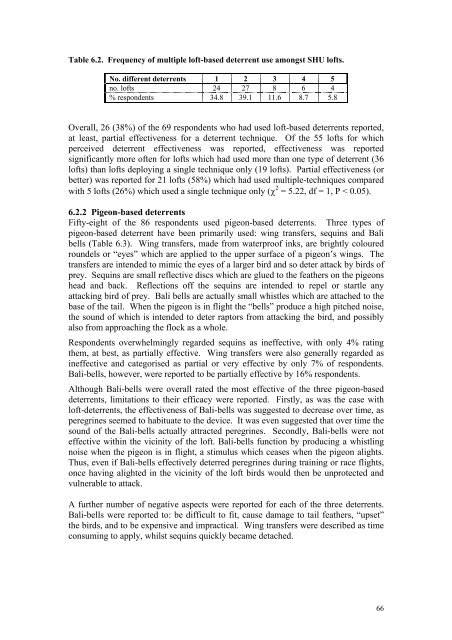RACING PIGEONS â IMPACT OF RAPTOR PREDATION
RACING PIGEONS â IMPACT OF RAPTOR PREDATION
RACING PIGEONS â IMPACT OF RAPTOR PREDATION
You also want an ePaper? Increase the reach of your titles
YUMPU automatically turns print PDFs into web optimized ePapers that Google loves.
Table 6.2. Frequency of multiple loft-based deterrent use amongst SHU lofts.<br />
No. different deterrents 1 2 3 4 5<br />
no. lofts 24 27 8 6 4<br />
% respondents 34.8 39.1 11.6 8.7 5.8<br />
Overall, 26 (38%) of the 69 respondents who had used loft-based deterrents reported,<br />
at least, partial effectiveness for a deterrent technique. Of the 55 lofts for which<br />
perceived deterrent effectiveness was reported, effectiveness was reported<br />
significantly more often for lofts which had used more than one type of deterrent (36<br />
lofts) than lofts deploying a single technique only (19 lofts). Partial effectiveness (or<br />
better) was reported for 21 lofts (58%) which had used multiple-techniques compared<br />
with 5 lofts (26%) which used a single technique only (χ 2 = 5.22, df = 1, P < 0.05).<br />
6.2.2 Pigeon-based deterrents<br />
Fifty-eight of the 86 respondents used pigeon-based deterrents. Three types of<br />
pigeon-based deterrent have been primarily used: wing transfers, sequins and Bali<br />
bells (Table 6.3). Wing transfers, made from waterproof inks, are brightly coloured<br />
roundels or “eyes” which are applied to the upper surface of a pigeon’s wings. The<br />
transfers are intended to mimic the eyes of a larger bird and so deter attack by birds of<br />
prey. Sequins are small reflective discs which are glued to the feathers on the pigeons<br />
head and back. Reflections off the sequins are intended to repel or startle any<br />
attacking bird of prey. Bali bells are actually small whistles which are attached to the<br />
base of the tail. When the pigeon is in flight the “bells” produce a high pitched noise,<br />
the sound of which is intended to deter raptors from attacking the bird, and possibly<br />
also from approaching the flock as a whole.<br />
Respondents overwhelmingly regarded sequins as ineffective, with only 4% rating<br />
them, at best, as partially effective. Wing transfers were also generally regarded as<br />
ineffective and categorised as partial or very effective by only 7% of respondents.<br />
Bali-bells, however, were reported to be partially effective by 16% respondents.<br />
Although Bali-bells were overall rated the most effective of the three pigeon-based<br />
deterrents, limitations to their efficacy were reported. Firstly, as was the case with<br />
loft-deterrents, the effectiveness of Bali-bells was suggested to decrease over time, as<br />
peregrines seemed to habituate to the device. It was even suggested that over time the<br />
sound of the Bali-bells actually attracted peregrines. Secondly, Bali-bells were not<br />
effective within the vicinity of the loft. Bali-bells function by producing a whistling<br />
noise when the pigeon is in flight, a stimulus which ceases when the pigeon alights.<br />
Thus, even if Bali-bells effectively deterred peregrines during training or race flights,<br />
once having alighted in the vicinity of the loft birds would then be unprotected and<br />
vulnerable to attack.<br />
A further number of negative aspects were reported for each of the three deterrents.<br />
Bali-bells were reported to: be difficult to fit, cause damage to tail feathers, “upset”<br />
the birds, and to be expensive and impractical. Wing transfers were described as time<br />
consuming to apply, whilst sequins quickly became detached.<br />
66
















